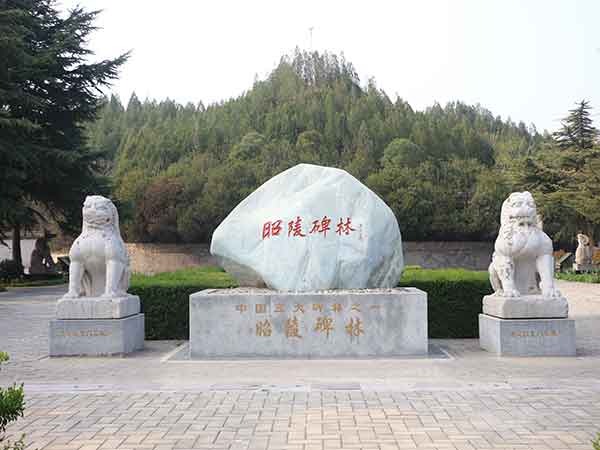Zhao Mausoleum, or Zhao Ling, is the tomb of the second emperor of
Tang Dynasty whose name was
Li Shimin, also called
Emperor Taizong. It is known as the largest royal mausoleum in the world. Also, it is the first batch of key units of cultural relics protection in China.
Introduction
Zhao Mausoleum is located in Jiuzong mountain,
Shaanxi
province, China. To its west side, it is 70 kilometers away from
Xi’an, 30 kilometers away from Xianyang, 25 kilometers away from Xianyang International Airport. Zhao Mausoleum is 60 kilometers in perimeter, covering an area of 200 square kilometers, having a total of more than 180 subordinate tombs. It is China’s largest royal mausoleum with the most subordinate tombs. Also, it is the representative of the emperor mausoleum in Tang Dynasty. From Zhenguan period (636 AD) when the Empress Zhangsun was first buried in Zhao Mausoleum to 743 AD, the construction of Zhao Mausoleum had been sustained for about 107 years. There are a large number of underground cultural relics in Zhao Mausoleum. These are the real testimony for us to know the transform from early Tang Dynasty to the flourishing Tang Dynasty. Moreover, all these relics are the scarce treasures for us to learn the politics, economy and culture of Chinese Feudal Society and Tang Dynasty.
Origin
After Emperor Taizong’s death, this great emperor was buried in Zhao Mausoleum. Zhao Mausoleum was constructed at the top of Jiuzong Mountain, launching the practice of Tang emperors constructing their tombs close to mountain peaks. This kind of tomb seems far more impressive than do those of heaped earth. This new practice was believed to have came from burying Empress Zhangsun, who on her death-bed asked Li Shimin to hold a thrifty and simple funeral, saying “please bury me on the mountain and do not heap the grave.” An inscription by Li Shimin says: “A ruler takes the entire land under Heaven being his home. Why should he retain treasures inside his tomb, owning them being his private property? Since the tomb has been constructed on Jiuzong Mountain with no horses, slaves, jade and gold inside and the household utensils all composed of wood and earth, robbers and thieves will quit their attempts, saving trouble for every one.” It is clear that to construct tombs like this was not for frugality and simplicity but for demonstrating the ruler’s stature and power through the spectacular mountain as well as preventing looting and grave-breaking. As a result, as soon as Empress Zhangsun was buried, Zhao Mausoleum’s site and name had already been decided.
Appearance and structure

The mausoleum was chiseled in the mountain that is 1,188 meters above sea level, and leans against the highest peak of Jiujun Mountain. The mausoleum area, the subordinate tombs and the grave make up the most typical building group of the mausoleum. The vast mausoleum is 12 km in length along with 10 km in width and there are cypresses and pines around it. The majority of the ground construction flattened and is hardly found. The Xuanwu Gate in the north side, the watchtower and the Xian Hall of the Zhuque Gate on the south side, and the wall base of the sacrificial altar will always be vaguely noticeable. A piece of ornament of roof ridges, once unearthed at the site of the Xian Hall, is 1.5 meters in height, 0.65 meters in width along with a 1 meter length bottom. From this you can see the grandness and the spectacularity of the unique Xian Hall. The stone statues of 14 kings are preserved in the sacrificial altar of the mausoleum. Besides, there were 6 world-famous stone reliefs horses (1.7m x 2.0m each) called the Six Steeds of Zhao Mausoleum. They are Saluzi (飒露紫), Qingzhui (青骓),Telebiao (特勒骠), Baitiwu (白蹄乌),Quanmaogua (拳毛騧) and Shifachi (什伐赤).The steeds were six precious war horses of Taizong, but they were destroyed in 1914. Two of them were shipped in secret to the museum of the University of Pennsylvania in Philadelphia, US and the other four had been repaired and displayed in Shanxi Province. All these sculptures fully showed the art style of the stone carvings and paintings in the early Tang Dynasty. In the mausoleum you can find more than 200 satellite tombs. Owners of 167 tombs have already been identified. Within the excavation in 1964, 13 large tombs were excavated, and 56 inscriptions on the gravestones and memorial tablets were discovered. The inscriptions on the tablet show that all of these were tombs of kings, princesses and famous ministers, such as Zheng Rentai, princess Linchuan and junior officer Chi Jingde. Types of stone statues are conserved in front of many tombs today. In 1979, a museum called Zhaoling Museum was established at the site of the Zhaoling Mausoleum and many related cultural relics were on display in it for tourists. Those relics includes Chinese porcelain, red Chinese pottery, coloured drawing or pattern and
tri-coloured glazed pottery of the Tang Dynasty.
Zhao Mausoleum is really a treasure of the Tang Dynasty, since it demonstrates the features and flourish of culture, economy and politics of the Tang Dynasty. It is definitely worth your visit.

